- How can I get to the facility from the nearest station?
-
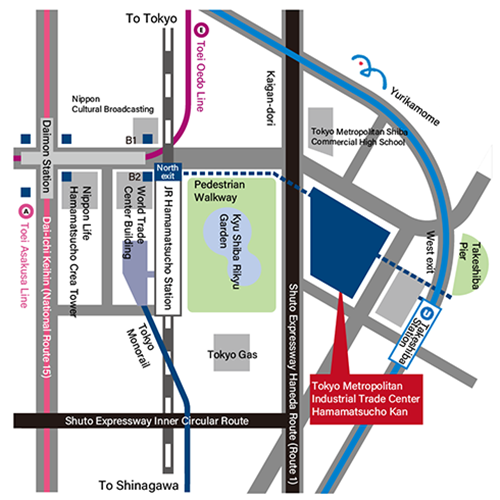
5-minute walk from the north exit of JR Hamamatsucho Station (JR Yamanote Line and Keihin Tohoku Line)
5-minute walk from Monorail Hamamatsucho Station (Tokyo Monorail)
7-minute walk from Exit B2 of Daimon Station (Toei Asakusa Line and Tokei Oedo Line (subway))
2-minute walk from Takeshiba Station (Yurikamome)
Click here for details.
※Image is for illustrative purposes only.
Facility Information
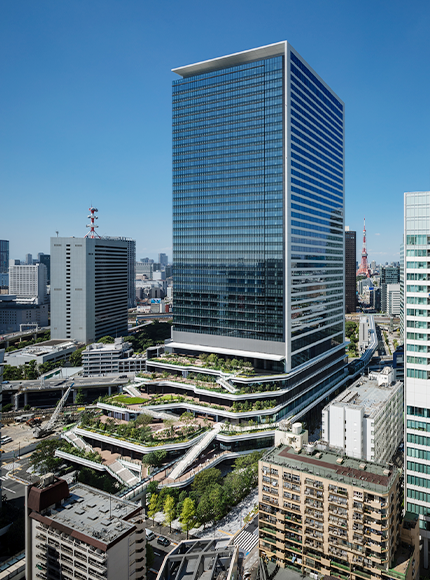
The Perfect Hub for Creating New Business Opportunities Hamamatsucho-Kan
On September 14, 2020, Hamamatsucho-Kan will open on the second to fifth floors of the new Tokyo Portcity Takeshiba office tower. As a core venue for small and medium-sized enterprises to make contacts and develop domestic and international markets, Hamamatsucho-Kan will be available for exhibitions, trade fairs, seminars, and other events, supporting industry in Tokyo.
The Tokyo Portcity Takeshiba office tower is a part of the Tokyo Urban Renewal Upgrade Project currently underway in the Hamamatsu-cho and Takeshiba area and will augment the commercial appeal of the area. In addition to excellent access from Haneda Airport, Shinagawa Station and Tokyo Station, this commercial district is known for its abundant green parks, historical Zojo-ji Temple, Tokyo Tower and many other noteworthy locations.
The staff and administration at Hamamatsucho-Kan look forward to serving your business needs.
Floor Guide
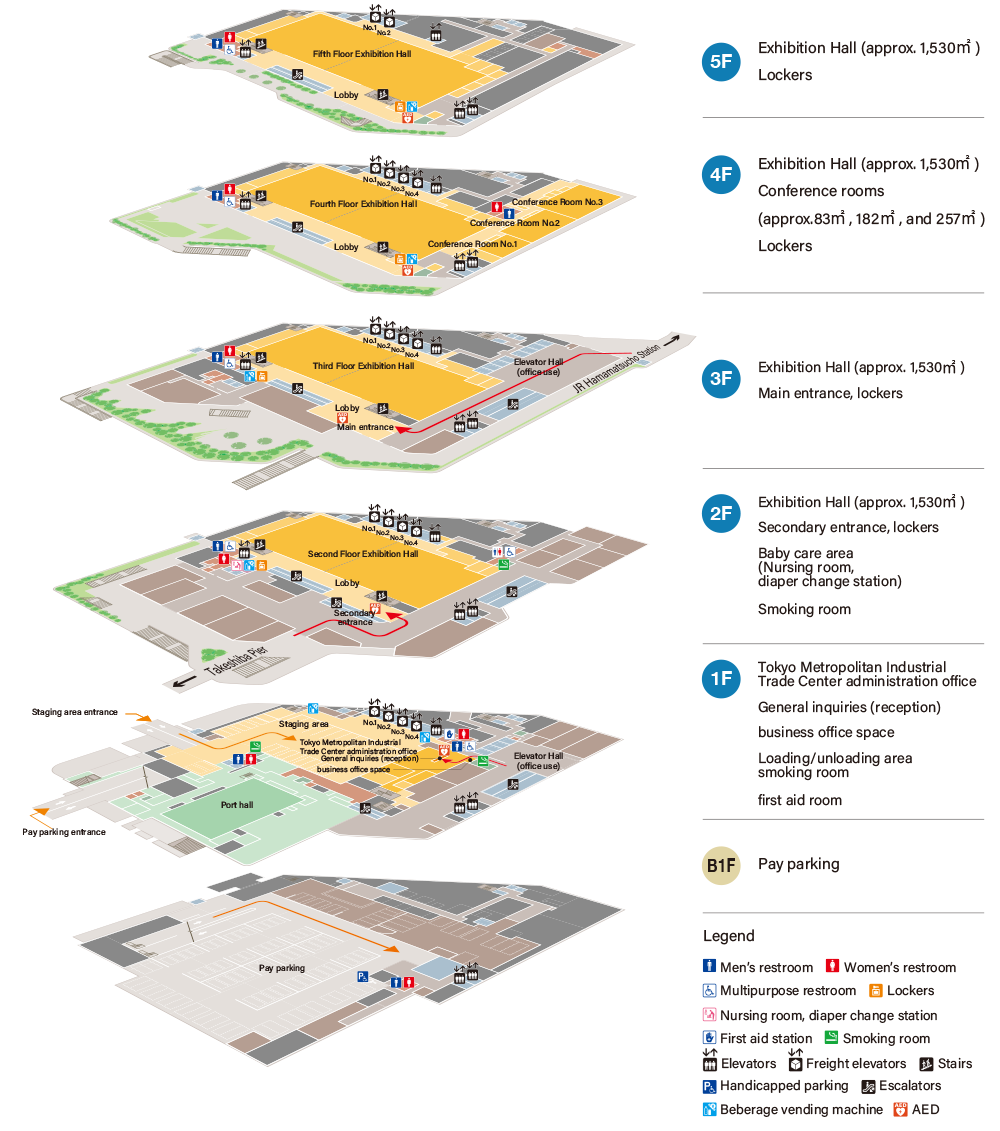
Facility Description
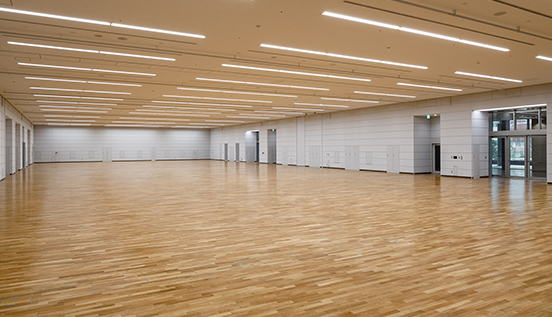
Exhibition Halls (2・3・4・5F)
The second to fifth floors each has an exhibition hall about 1,500 ㎡ in size. With five meters high ceilings and no columns, the spacious halls are perfect for a wide range of uses, including exhibitions, trade fairs, seminars, work fairs, exams and art exhibitions. Sliding partitions are also available to use the halls as half-sized spaces.
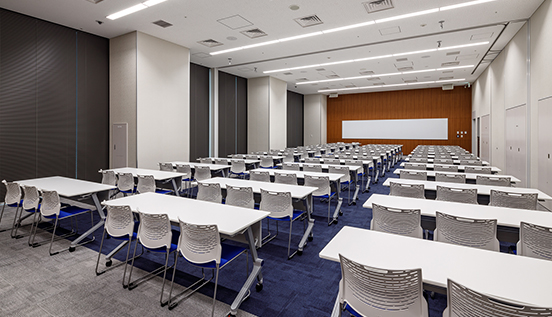
Conference Rooms (4F)
The fourth floor has three conference rooms, from small to large in size. These rooms can be used for training, seminars, consultations, interviews and much more. They are also excellent for conferences held in conjunction with events or as spare rooms. Sliding partitions are also available to use the rooms as half-sized spaces.
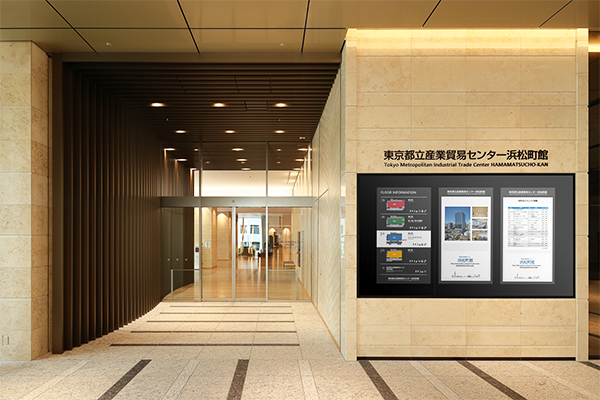
Main Entrance (3F)
The main entrance to Hamamatsucho-Kan is connected to JR Hamamatsucho Station by a convenient pedestrian walkway. From the entrance, quickly access any of the exhibition halls or conference rooms on floors two to five.
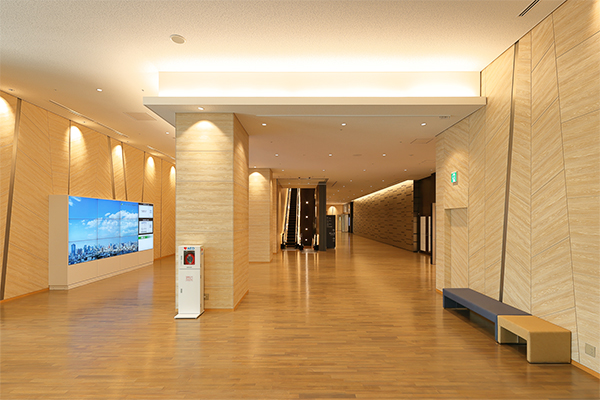
Lobbies
The flooring of the exhibition hall lobbies is made from Tama lumber (produced locally in Tokyo's Tama region). The cheerful atmosphere gives visitors a warm welcome.
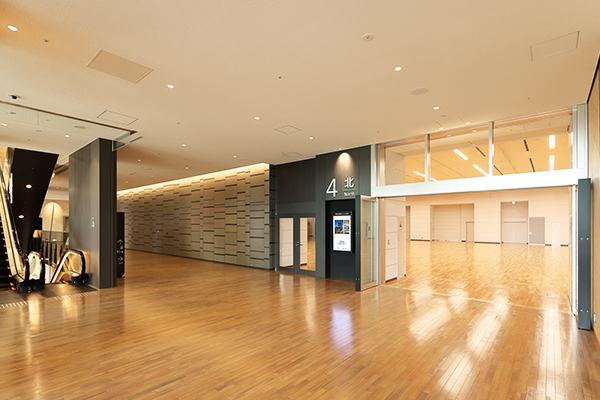
Open Space Design
The open design of the exhibition halls ensures that visitors can easily join the venue.
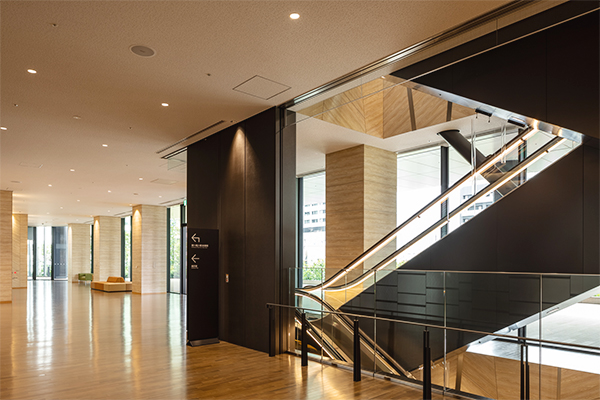
Connecting Escalators
The open-space lobbies serve as foyers for welcoming visitors to the exhibition spaces. Escalators are conveniently located between lobbies for easy access between floors.
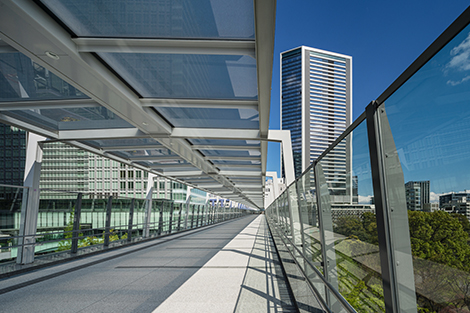
Pedestrian Walkway to Third Floor Entrance
A covered walkway takes pedestrians directly to the main entrance, bypassing intersections and traffic signals on the street level.
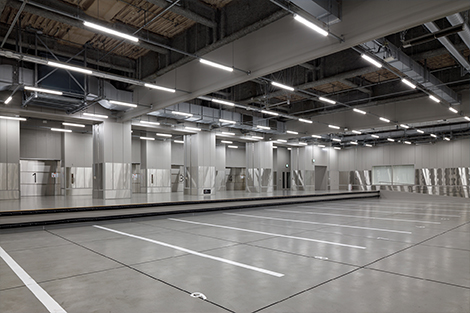
Loading and Unloading Area (1F)
The loading and unloading area is equipped with four freight elevators (max. weight load: 3 or 5 tons) and a platform (height: 0.72 m) for efficiency.

Baby Care Area (2F)
(Nursing Room and Diaper Change Station)
For those with infants and small children, Hamamatsucho-Kan has facilities for nursing, changing diapers, and other caregiving needs.
Facility information
| Rental Exhibition Halls |
|
|---|---|
| Rental Rooms |
|
| Rental Conference Rooms |
|
| Administration Room Business Office Space |
|
| Baby Care Area (Nursing Room, Diaper Change Station) |
|
| Smoking Rooms |
|
| First Aid Station |
|
| Loading Unloading Area |
|
Equipment Information
| Escalators | 2-5F Located between exhibition hall lobbies (width: 600 mm) |
|---|---|
| Passenger elevators |
2–5F 1–5F B1–B6 |
| Freight elevators (exhibition hall loading area access) |
1-5F
1–5F 1–4F 1–5F |
| General restrooms |
1・2F 2–5F 4F |
| Multipurpose restrooms |
1・2F 2–5F |
Area Guide
Information on Nearby Facilities
Information on the area around HAMAMATSUCHO-KAN.
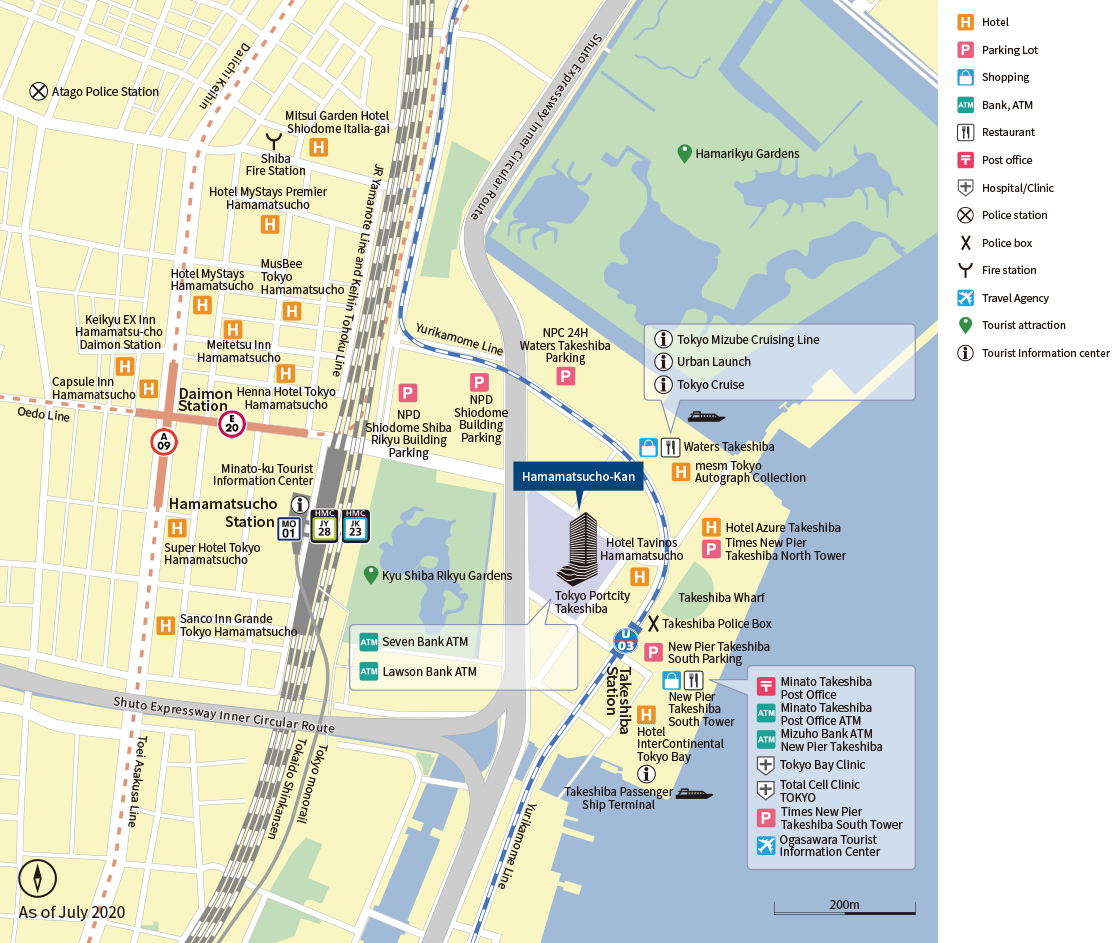
Representative Tourist Attractions
Let us introduce representative tourist attractions near Tokyo Portcity Takeshiba, where Hamamatsucho-Kan is located.
Situated on the Tokyo Bay Waterfront, the Takeshiba area is easily accessible from various parts of Tokyo, including JR Hamamatsucho Station via the Tokyo Monorail that connects Hamamatsucho Station and Haneda Airport, the Oedo and Asakusa subway lines, and the Yurikamome line.
Although located in downtown Tokyo, the area is blessed with rich greenery. At Kyu Shiba Rikyu Garden and Hamarikyu Garden, visitors can enjoy historical and cultural landscapes.
Takeshiba Pier serves as the gateway to the Izu Islands and Ogasawara Islands (inscribed on the UNESCO World Heritage List).
Enjoy the charms of Takeshiba, where you can appreciate lush greenery and a spacious view from the pier, just a few minutes' walk from the nearest station.
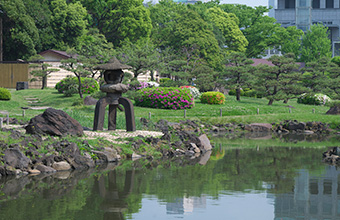
Kyu Shiba Rikyu Garden
Historic Japanese garden where visitors can view dynamic stone arrangements
Kyu Shiba Rikyu Garden is a public garden in Tokyo just a short walk from Hamamatsucho Station. It was originally called Rakujuen, a garden of the official residence of Okubo Tadatomo, a daimyo (feudal lord) in the Edo period, After becoming a detached palace managed by the Imperial Household Agency, it was donated to Tokyo City in 1924 and opened to the public as Kyu Shiba Rikyu Garden.
The garden's history is reflected in its many famous stones. The stone arrangements in Nebukawayama and Nakajima are well worth viewing.
This traditional Japanese garden enveloped by modern skyscrapers creates a wonderful harmony, representing today's Tokyo.
Let's Go to the Gardens (Kyu Shiba Rikyu Garden)【External Link】
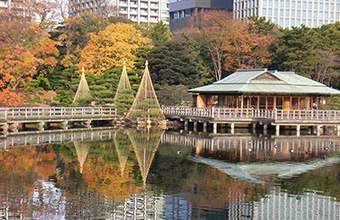
Hamarikyu Garden
Representative garden built by daimyo in the Edo period and featuring Shioiri-no-ike pond
Hamarikyu Garden is a representative garden built by daimyo in the Edo period with a Shioiri-no ike (incoming tide pond) and two Kamoba (duck hunting sites).
Shioiri-no-ike draws in seawater. The atmosphere of the pond changes with the rise and fall of the tides—a method that was commonly used in the past at seashore gardens. Currently, this is the only public garden in Tokyo where seawater ebbs and flows.
It is also the only seawater pond that was made in the Edo Period among ponds in Tokyo Metropolitan public parks.
The 300-Year Pine is said to have been planted to celebrate the renovation of the garden by the 6th Shogun Ienobu. It has survived even until this day, and stands magnificently strong.
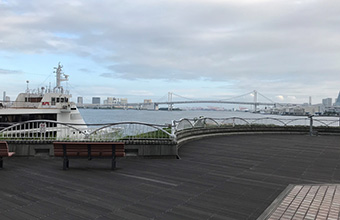
Takeshiba Passenger Ship Terminal
Gateway on the sea connecting central Tokyo with remote islands
Takeshiba Pier is located just a few minutes' walk from Takeshiba Station on the Yurikamome line, and serves as the gateway on the sea connecting central Tokyo with a number of remote islands such as the Izu Islands and Ogasawara Islands. At the Rinko Hiroba port square, visitors can see cruise ships come and go akin to a canal, and enjoy the contrast between the spacious view and modern cityscape.
Visitors can enjoy a sweeping view of the departure and arrival of ships in Tokyo Bay from the roof of the terminal building, which provides a space for relaxation.
Recommended for those who like watching ships.
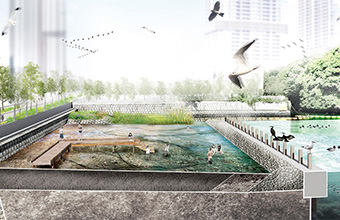
Takeshiba Tideland
Initiatives to restore the environment of Tokyo Bay
Tokyo Bay once provided a habitat for various species, including shellfish and crustaceans.
In order to restore and preserve a sustainable environment, efforts to make tideland are underway in the Takeshiba area.
Since July 2020, activities to restore Tokyo Bay's environment and foster environmental learning have been carried out in Takeshiba Tideland with the cooperation of educational and research organizations.
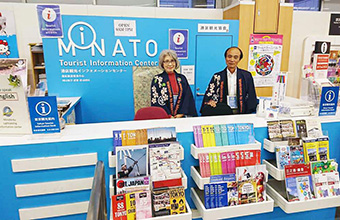
Minato-ku Tourist Information Center
Tourist Information Center at Hamamatsucho Station on the Tokyo Monorail
You can find this tourist information center in front of the automatic ticket gate in the concourse on 3F of Tokyo Monorail Hamamatsucho Station.
Services are provided in multiple languages, including English. You can pick up tourist attraction brochures as your travel companion.
The staff also offer transportation information. Please feel free to visit.
Tokyo Travel Guide GO TOKYO
Access
Directions from nearest station

Tokyo Metropolitan Industrial Trade Center Hamamatsucho-Kan
[Address] 1-7-1,Kaigan,Minato-ku,Tokyo, 105-7501
[TEL] 03-3434-4242
[FAX] 03-3434-4648
5-minute walk from JR Hamamatsucho Station (north exit)
Via the pedestrian deck (video guide)
From the 1st floor (video guide)
When coming by train
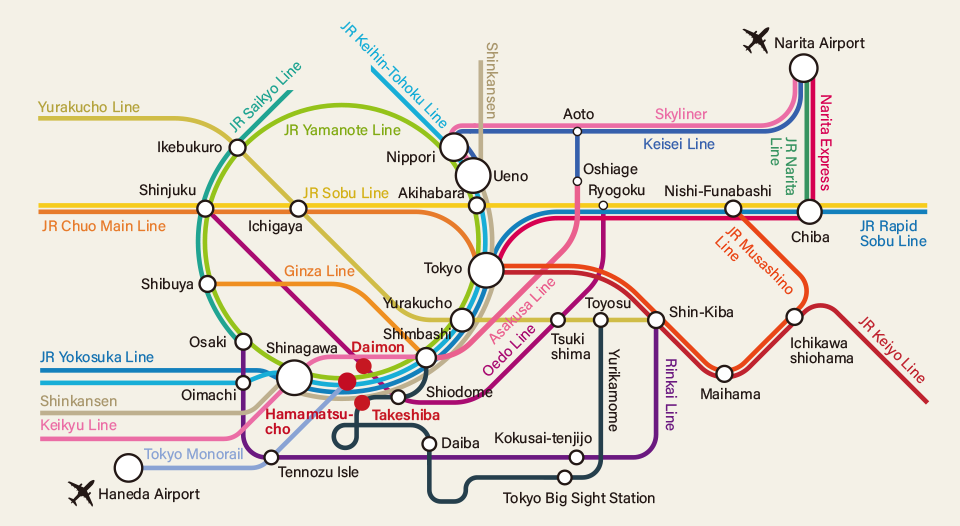
| Hamamatsucho Station |
JR A five-minute walk (350 m) from Hamamatsucho Station (north exit) Exit to Takeshiba-dori and proceed toward Takeshiba Pier. |
|---|---|
| Tokyo Monorail |
A five-minute walk (350 m) from Hamamatsucho Station (north exit) After exiting the monorail ticket gate, turn right at the front entrance of the World Trade Center Building and proceed toward Takeshiba Pier. |
| Yurikamome |
Yurikamome (new option) A two-minute walk (100 m) from Takeshiba Station After leaving the ticket gate, go out the west exit and proceed toward Hamamatsucho Station. |
| Toei Asakusa Line |
Toei Asakusa Line (subway) A seven-minute walk (450 m) from Daimon Station Leaving the Daimon/ Hamamatsucho Station ticket gate, go out the B2 exit. When outside, go past JR Hamamatsucho Station (north exit) toward Takeshiba Pier. |
| Toei Oedo Line |
Toei Oedo Line (subway) A seven-minute walk (450 m) from Daimon Station Leaving the Daimon/ Hamamatsucho Station ticket gate, go out the B2 exit. When outside, go past JR Hamamatsucho Station (north exit) toward Takeshiba Pier. |
The times shown are travel times and do not include the time required for transfers.
When coming by car
| Highway | Approx. 10 minutes from the Shiba-koen or Shiodome interchange on the Shuto Expressway Inner Circular Route, or from the Shibaura interchange on the Shuto Expressway Haneda Route. Shared-used pay parking facilities are available on the B1 level. |
|---|
We do not provide a parking lot for public use. Please use a nearby parking lot when coming by car.
Click here to search for nearby parking lots. External Link(JP)
When coming from the airport
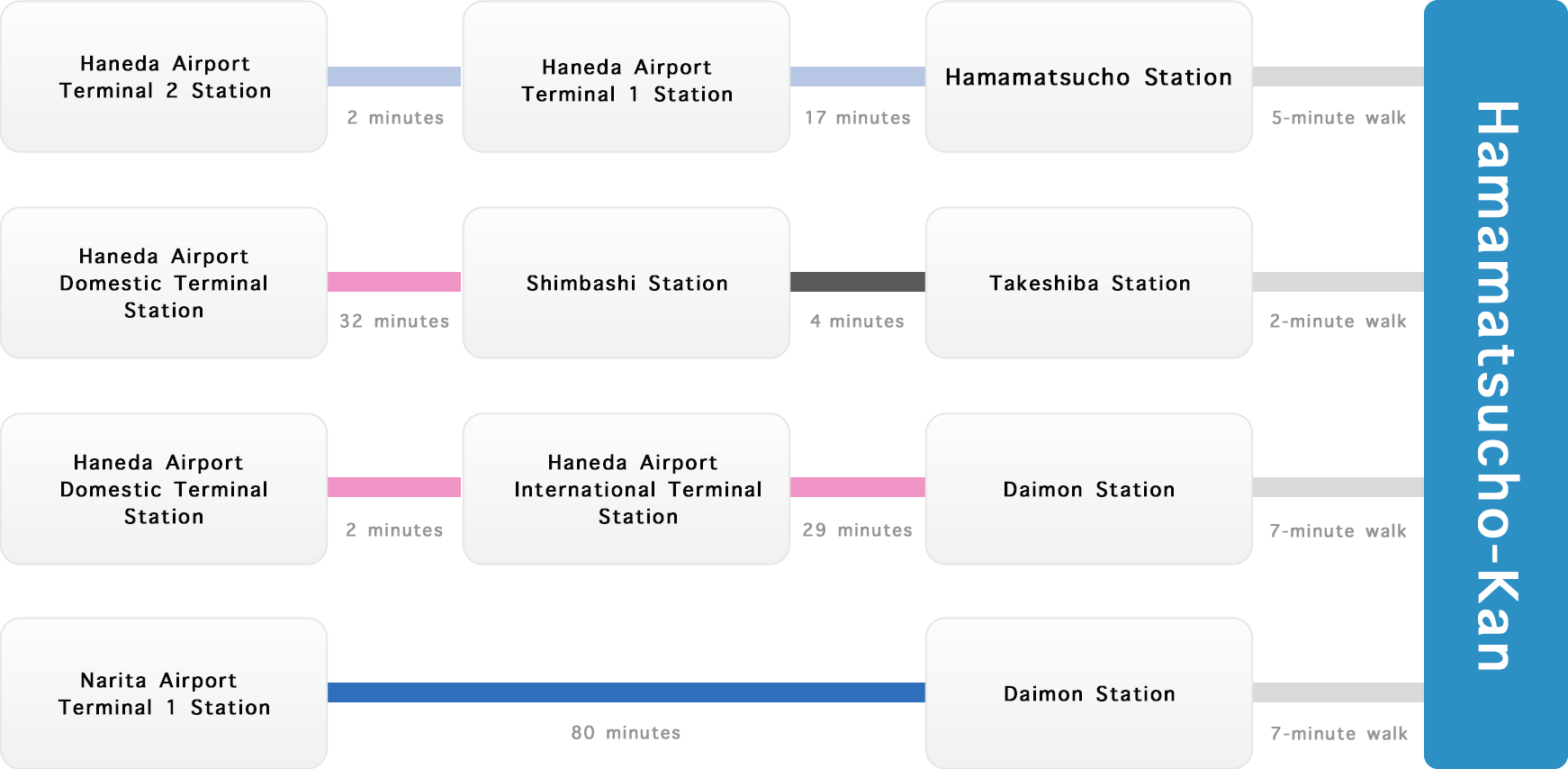
The times shown are travel times and do not include the time required for transfers.
FAQ
Q&A related to Access and Parking Lots
- Is there a parking lot?
-
There is a pay parking lot on B1F for visitors to the building. (Note that it is not a dedicated parking lot for the Industrial Trade Center) Click here for other detailed information on parking lots.
Q&A related to Facilities and Services
- What first aid facilities are available?
-
There is a first aid room with a bed for use by visitors who temporarily require bed rest; however, no doctors or nurses are stationed. In the case of sudden illness, we recommend that you visit a medical facility or call an ambulance.
- Are there any restaurants?
-
There is a restaurant area on 2F of the Tokyo Portcity Takeshiba Office Tower, where the Tokyo Metropolitan Industrial Trade Center Hamamatsucho-Kan is located.
Shop Information of Tokyo Portcity Takeshiba
※In the language selection window, you can select English, Korean, Simplified Chinese, or Traditional Chinese.
- Who should I contact about lost items?
-
Contact the administration office.
TEL:03-3434-4242Lost items are temporarily retained at the administration office.
Valuables such as cash, mobile phones, and credit cards are sent to the Takeshiba Police Box on the day they are found.Atago Police Station
TEL:03-3437-0110 (main number)
- Is there a nursing room and a diaper changing station?
-
An "Akachan Furatto" baby care area (nursing room and diaper change station) is available for use on 2F. Please feel free to use it.
- Are there lockers?
-
There are lockers on 2F, 3F, 4F and 5F (for a fee).
Q&A related to the Industrial Trade Center
- When are the regular holidays of the Industrial Trade Center?
-
The Center is closed during the following periods:
- 【Closed】 December 29–December 31, and January 1–January 3
- When considered necessary, the Center may change the period above or close temporarily.
- In addition to the above periods, visitors may not be admitted to the facilities or the building during maintenance and inspection, repair work or electric outage of the building or other reasons.
- Is the facility handicapped-accessible?
-
- Wheelchair-accessible restrooms (also for ostomates): 2F, 3F, 4F and 5F
Wheelchair-accessible restrooms are available for use next to visitor restrooms on the south side on 2F, 3F, 4F and 5F. These restrooms are also for ostomates. - Tactile restroom map: 2F, 3F, 4F and 5F
Tactile restroom maps are available on 2F, 3F, 4F and 5F. - Voice guidance for the building facilities: 1F, 2F, 3F, 4F and 5F
A sound sign guidance system is available at the entrance of the administration office on 1F and at the entrances of the Industrial Trade Center on 2F, 3F, 4F and 5F. - Voice guidance (restrooms): 2F, 3F, 4F and 5F
Voice guidance for the restrooms is available on 2F, 3F, 4F and 5F.
- Wheelchair-accessible restrooms (also for ostomates): 2F, 3F, 4F and 5F
- Where is the evacuation shelter in case of a disaster?
-
Kaigan 1-chome in Minato-ku is designated as an area where evacuation to a safety evacuation area is not necessary, with a low risk of fire spread in case of an earthquake disaster.
As one of Tokyo's evacuation shelters, the Tokyo Metropolitan Industrial Trade Center is designated as a temporary stay facility that accepts people stranded with no way home in the event of a major disaster.
In case public transport such as railway and bus services stop due to a large earthquake, the Center will accept users, visitors and others who are stranded with no way home as a temporary stay facility, after safety of the Center has been confirmed. In accordance with the policy of the Tokyo Metropolitan Government, the Center offers disaster information, food and drinking water as well as other supplies to those stranded with no way home.


